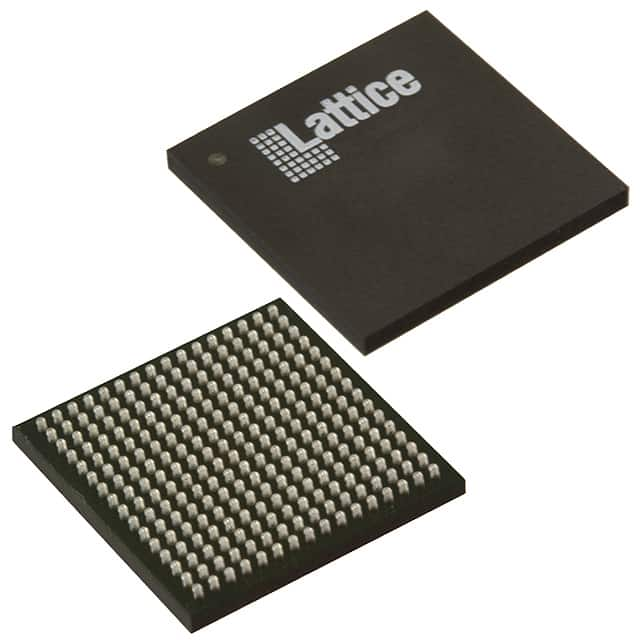Voir les spécifications pour les détails du produit.

LFE5U-12F-6BG256C
Product Overview
Category
The LFE5U-12F-6BG256C belongs to the category of Field Programmable Gate Arrays (FPGAs).
Use
This FPGA is commonly used in various electronic applications that require high-performance digital logic circuits.
Characteristics
- High flexibility and reconfigurability
- Ability to implement complex digital systems
- Low power consumption
- High-speed data processing capabilities
Package
The LFE5U-12F-6BG256C comes in a BG256 package, which refers to a ball grid array with 256 balls.
Essence
The essence of this FPGA lies in its ability to be programmed and reprogrammed to perform different functions, making it highly versatile for a wide range of applications.
Packaging/Quantity
The LFE5U-12F-6BG256C is typically packaged individually and is available in single quantities.
Specifications
- FPGA Family: Lattice ECP5
- Logic Elements: 12,000
- Speed Grade: -6
- Package Type: BG256
- I/O Pins: 256
- Operating Voltage: 1.2V
- Maximum Frequency: 400 MHz
- Embedded Memory: 640 kbits
- DSP Slices: 30
- Configuration: Non-volatile Flash
Detailed Pin Configuration
The LFE5U-12F-6BG256C has a total of 256 I/O pins, each serving a specific purpose in the circuit design. The pin configuration can be found in the product datasheet provided by the manufacturer.
Functional Features
- High-speed data processing
- Reconfigurable logic elements
- On-chip memory for data storage
- Digital signal processing capabilities
- Support for various communication protocols
- Flexible I/O options
Advantages and Disadvantages
Advantages
- Flexibility in design and reconfiguration
- Low power consumption
- High-speed data processing
- Support for various communication protocols
- On-chip memory for data storage
Disadvantages
- Complexity in programming and design
- Higher cost compared to other digital logic solutions
- Limited availability of alternative models
Working Principles
The LFE5U-12F-6BG256C operates based on the principles of field programmable gate arrays. It consists of a matrix of configurable logic elements interconnected through programmable routing resources. These logic elements can be programmed to perform specific functions, allowing the FPGA to implement complex digital systems.
Detailed Application Field Plans
The LFE5U-12F-6BG256C finds applications in various fields, including: 1. Telecommunications: Used in base stations, network switches, and routers. 2. Industrial Automation: Employed in control systems, robotics, and machine vision. 3. Aerospace and Defense: Utilized in radar systems, avionics, and secure communications. 4. Medical Devices: Integrated into imaging systems, patient monitoring devices, and diagnostic equipment. 5. Automotive: Applied in advanced driver-assistance systems (ADAS), infotainment systems, and engine control units.
Detailed and Complete Alternative Models
While the LFE5U-12F-6BG256C is a highly capable FPGA, there are alternative models available from different manufacturers that offer similar functionality. Some notable alternatives include: - Xilinx Virtex UltraScale+ - Intel Stratix 10 - Microsemi PolarFire
These alternative models provide comparable features and performance, offering designers a range of options to choose from based on their specific requirements.
Word count: 446 words
Énumérez 10 questions et réponses courantes liées à l'application de LFE5U-12F-6BG256C dans les solutions techniques
Sure! Here are 10 common questions and answers related to the application of LFE5U-12F-6BG256C in technical solutions:
Q: What is the LFE5U-12F-6BG256C? A: The LFE5U-12F-6BG256C is a field-programmable gate array (FPGA) from the Lattice ECP5 family, offering low power consumption and high performance.
Q: What are the key features of the LFE5U-12F-6BG256C? A: Some key features include 12K Look-Up Tables (LUTs), 256-pin Ball Grid Array (BGA) package, 6 Gbps SERDES channels, and support for various I/O standards.
Q: What applications can benefit from using the LFE5U-12F-6BG256C? A: The LFE5U-12F-6BG256C is commonly used in applications such as industrial automation, telecommunications, video processing, and embedded systems.
Q: How does the LFE5U-12F-6BG256C contribute to power efficiency? A: The LFE5U-12F-6BG256C incorporates power-saving features like dynamic power management, clock gating, and low-power standby modes to optimize energy consumption.
Q: Can the LFE5U-12F-6BG256C handle high-speed data transmission? A: Yes, the LFE5U-12F-6BG256C supports 6 Gbps SERDES channels, making it suitable for applications requiring high-speed data transmission or serial communication.
Q: Is the LFE5U-12F-6BG256C compatible with different I/O standards? A: Yes, the LFE5U-12F-6BG256C supports various I/O standards such as LVCMOS, LVTTL, LVDS, and SSTL, providing flexibility in interfacing with different devices.
Q: Can the LFE5U-12F-6BG256C be reprogrammed after deployment? A: Yes, the LFE5U-12F-6BG256C is a field-programmable device, allowing for reprogramming of the FPGA even after it has been deployed in a system.
Q: What development tools are available for programming the LFE5U-12F-6BG256C? A: Lattice provides the Lattice Diamond design software, which includes a complete suite of tools for designing, implementing, and debugging FPGA designs.
Q: Are there any reference designs or application notes available for the LFE5U-12F-6BG256C? A: Yes, Lattice offers a wide range of reference designs and application notes that provide guidance and examples for using the LFE5U-12F-6BG256C in different applications.
Q: Where can I find technical support or documentation for the LFE5U-12F-6BG256C? A: Lattice provides comprehensive technical support through their website, including datasheets, user guides, application notes, and access to their support team for any specific queries or issues.
Please note that the answers provided here are general and may vary depending on the specific requirements and use cases. It's always recommended to refer to the official documentation and consult with experts for accurate information.

